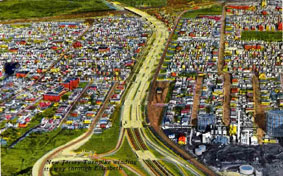talking history | syllabi | students | teachers | puzzle | about us
What Exit? New Jersey and Its Turnpike
http://www.jerseyhistory.org/what_exit/index.html.
Created by the New Jersey Historical Society in conjunction with the American Social History Project. Janet Rassweiler, project director; Ellen M. Snyder-Grenier, online exhibition curator; Pennee Bender, producer; Andrea Ades Vasquez, co-producer and designer; Joshua Brown, co-producer and artist.
Reviewed Nov. 10–11, 2003.
For those who know the state mainly by driving through it, the New Jersey Turnpike is New Jersey, a fact not always appreciated by natives. This online exhibit, created to commemorate the fiftieth anniversary of the highway’s opening in 1951, demonstrates the turnpike’s place in local identity as well. It is not just the old joke, which opens the exhibit, “What exit are you from?,” that matters. The turnpike, by inspiring popular culture and influencing social relations as well as creating a distinct landscape, has had a powerful influence in shaping New Jersey’s sense of itself.
Divided into three main sections—“Building It”, “Driving It”, and “Telling It”—the exhibit provides an easily navigated set of pathways illustrating the turnpike’s nature and impact. Introductory narratives provide context both for New Jersey and the nation. Film clips, not incidentially sponsored by beneficiaries from construction and operation, provide a window into the great anticipation behind such widely promoted public works projects. The inclusion of oral histories, song lyrics and poetry, and images of material and commercial culture suggest how the experience of traveling extended well beyond movement between discrete locations into sites of memory. An extensive bibliography and a set of linkages allow visitors of all ages to pursue their interests in the general subject of automobile history and the New Jersey experience.

Turnpike Construction Divides a City
Elizabeth, New Jersey
Historians should find the site suggestive if not fully comprehensive. The exhibit does not shy away from the controversial elements that accompanied the more celebratory statements about the highway over the years. One section details the opposition to the highway department’s decision to run the turnpike directly through Elizabeth. The familiar bright colors of the picture postcard reproduced to demonstrate the results can only heighten the irony that “progress” had its costs. Similarly, a selection of news articles details the efforts of citizens in East Brunswick to blunt the ill effects of later improvements.
What remains missing, however, is a sense of the turnpike’s full impact. No doubt, the turnpike has inspired a number of artists, although songwriters are better represented than visual artists. But what was the demographic impact of the turnpike? To a considerable degree, the location of Exit 4 at Mount Laurel, in the southern end of the state, was responsible for development pressures pushing black farmers off the land, resulting in some of the most important state judicial rulings in modern history, the 1975 and 1983 Mount Laurel decisions requiring every New Jersey community to include its “fair share” of affordable housing in its mix of new residences. A number of other questions could be asked of the turnpike’s economic as well as social impact. To be fair, the site does a good job of placing the turnpike in a larger national context. In doing so, however, it may have underestimated how these ribbons of asphalt altered forever the Garden State!
Howard Gillette Jr.
Rutgers University
Camden, New Jersey
